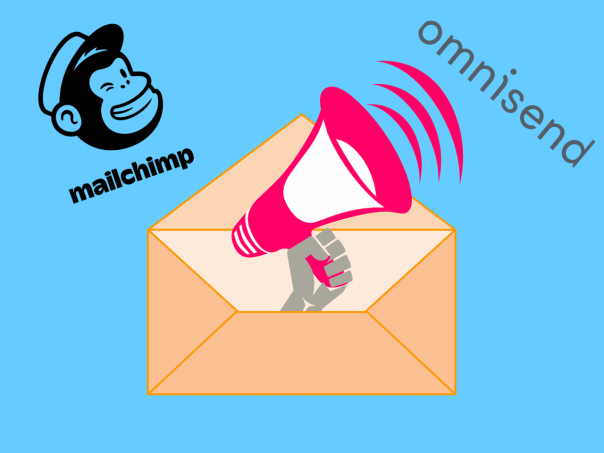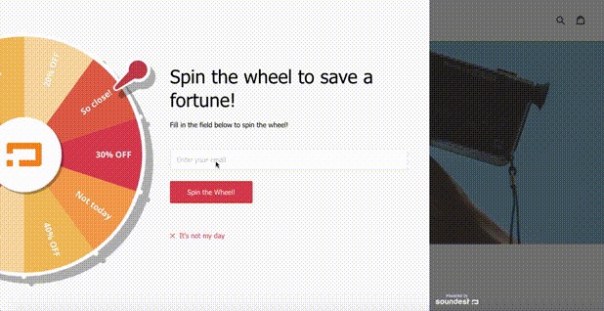
MailChimp is known for its great drag-and-drop email composer, intuitive interface and strong brand awareness. These are the main reasons why thousands of users have chosen MailChimp to start their first email marketing campaigns. But what about others? For example Omnisend vs Mailchimp?
However, marketers who have already warmed up in sending bulk promotional emails and want to try something more sophisticated often look for a Mailchimp alternative.
Especially now, after MailChimp has announced their withdrawal from Shopify, a number of marketers are lost and looking for another great email marketing solution.
Here, Omnisend gets the spotlight. This solution has been tailored for e-commerce needs and is a groundbreaking tool for thousands of marketers across the globe.
Originally developed as an email service platform, it has outgrown the generic email marketing approach.
Over recent years Omnisend has become a comprehensive marketing automation tool that enables marketers to implement the most effective marketing strategy today – integrated omnichannel marketing.
Now let’s take a close look at the features. Will you be able to have functionality on Omnisend that you’ve had on Mailchimp? And what’s more?
Omnisend vs. MailChimp: Email Capture
Comparing a toolkit for the email list building, we see the same most popular methods offered on both Mailchimp and Omnisend: pop-ups, static signup forms, and landing pages.
On both platforms, you can design and customize your signup forms, add additional fields for more information.
Both platforms offer pre-built forms and metrics to track list growth as well as form’s performance.
However, Omnisend offers an in-house interactive signup form that MailChimp doesn’t have and it makes the difference.

On Omnisend you can implement a Wheel of Fortune: an interactive signup form that effectively collects subscribers by offering them a chance to win a prize (usually a discount) by simply entering their email address and spinning the wheel.
This type of gamification boosts email list building significantly – success rate reaches 10%. So this is a feature definitely worth trying when using Omnisend.
Omnisend vs. MailChimp: Email Newsletters
MailChimp was one of the first platforms that offered truly user-friendly email composer.
Today, it’s not a trump card anymore.
Omnisend and many other email services providers have followed Mailchimp’s example and developed visual email composers which are easy to use and allow you to customize nearly any element in your newsletter.
In fact, when you compare Mailchimp and Omnisend’s visual composers, you can do incredible things with both platforms.
Mailchimp’s email builder:

Omnisend’s email builder:

When comparing both platforms, Mailchimp and Omnisend offer many of the same things around email building. Both include drag-and-drop block-based email builders. Both offer templates to help you get started quickly and easily. Both are completely mobile responsive and offer previews for mobile.
Both platforms provide a wide range of email templates, also A/B testing, email personalization, and product recommendation.
With mind, you can even personalize the products you recommend according to previous customer’s behavior. Also, it’s obvious that Omnisend is geared for e-commerce marketers. This is where the two platforms divide when it comes to email marketing.
When using Omnisend, you can eliminate from your schedule time-consuming tasks like collecting products into your newsletter or creating discount codes. This platform has a series of features that help you do your job quicker.
For example, a unique feature – the Product picker – imports your products with descriptions and prices into an email automatically once you click on the product in your store.
Email elements like discount codes and customers rewards are always ready to be dragged-and-dropped into your email.
You can even gamify your discounts by offering a flash scratch card or gift box that the customer unwraps for their prize. While this is something small, it’s also an interesting way to delight your customer.
Plus, thanks to in-depth integration with e-commerce platforms, marketers can see a number of orders and money earned by each separate campaign.
Trust me, a set of these e-commerce-focused features will save you time and facilitate your daily tasks significantly. E-commerce-friendly features are an absolute must for anyone who sells online.
Omnisend vs. Mailchimp: Marketing Automation and an Omnichannel Approach
Before starting to automate communication with the audience, marketers create segments. MailChimp has great segmentation for precise targeting. So does Omnisend. With Omnisend you can target your customers in a variety of ways: based on profile data, campaign engagement, and shopping behavior.
When it comes to marketing automation, MailChimp offers a nice set of pre-built email workflows. Besides email, using Mailchimp you can reach your customers via Google ads, and Facebook custom audiences.

However, Mailchimp’s automation leaves quite a bit to be desired. It’s good for a very basic email workflow, but anything outside of that won’t work very well on the platform.
Meanwhile, Omnisend, on top of the most popular automated workflows, has centralized a way more channels to reach customers.
In particular – email, SMS/text messages, Facebook Messenger, Google and Facebook ads, web push notifications, WhatsApp, and Viber.
What’s more, Omnisend’s automation workflows are considerably more visual, making them easy to understand.
This way, you can create more complex workflows involving all of those channels without getting lost in a list like you can in Mailchimp.
Some of these channels are more expensive, some of them more affordable.
You may choose which of them you will use according to the customer data you have and the budget you can allocate for the campaign.
So comparing these platforms from a marketing automation perspective, with Omnisend you can have the same features as with MailChimp.

But Omnisned gives you more flexibility and more channels you can use to convey your message to your customers.
So while Mailchimp can get the job done with email marketing automation, automation is where Omnisend really shines.
Omnisend goes much further by allowing you to add in other channels into the same automation workflow, meaning you don’t have to bounce back and forth between platforms, or even separate automation workflows.
Omnisend vs Mailchimp: Pricing
When it comes to pricing, Omnisend and Mailchimp are comparable. In certain cases, Omnisend is more expensive than Mailchimp, and in others, it’s vice-versa.
However, Mailchimp’s pricing can be confusing for some who are more used to a simple scale that increases with the number of subscribers you have.
Mailchimp Pricing:
Mailchimp offers a free forever plan that is limited to 2000 subscribers and 12,000 emails per month.
This free plan allows you to send bulk emails as much as you’d like (under your threshold, of course) but requires that you keep Mailchimp branding in your campaigns.
However, if you’re using any kind of marketing automation, even if you have only 1000 subscribers, you’re going to hit that 12,000 thresholds pretty quickly.
Alternatively, with the Grow plan, you can start off at just $10 per month.
However, this doesn’t just kick in after you’ve exceeded the free plan. $10 per month is for the first 500 subscribers, so if you end up actually outgrowing Mailchimp’s free plan, you’ll end up paying $30 per month.
If you opt for the Mailchimp Pro plan, it becomes a bit trickier.
You basically pay the amount of what you would pay with the Grow plan (which is based on the number of subscribers you have) plus $199 per month.
So for example, if you had 2001 subscribers, you would pay $229 per month with the Pro plan ($199 from the Pro plan, plus $30 from the Grow Plan).
Mailchimp does have a pricing calculator to help you find out how much you’ll pay in advance.
Omnisend Pricing:
Omnisend also offers a free plan that isn’t actually limited by subscriber count.
Their plan includes basic email marketing, including up to 15,000 emails per month and 2,000 emails per day. While that threshold is still easy to hit, it’s a bit better than MailChimp’s.
However, their free plan doesn’t come with the best features Omnisend has to offer, it’s just for those who need really basic email marketing.
From there, Omnisend’s Standard plan starts out at $16 per month for up to 500 subscribers. This plan is built for those who need to use email marketing automation and want a great visual platform to do it on.
As a bonus, you can also get started with SMS marketing (though it’s worth mentioning that you have to purchase credits for this and that each country is a bit different in terms of how much they charge for their SMS messages).
Omnisend’s Standard plan also allows you to add different modules so you can customize your plan if you’re not ready to get everything with their Pro plan.
The Omnisend Pro plan offers the full suite of great features this tool has, including omnichannel marketing, like adding in Facebook Messenger, SMS, Email, web push notifications, and more into automation workflows.
It starts off at $199 per month and scales with the number of subscribers you have.
While the pricing between both Mailchimp and Omnisend are figured in different ways, they’re pretty similar as you grow.
Like Mailchimp, Omnisend also offers a pricing calculator to help you figure out how much each plan would cost for your e-commerce store.
Check the Quick Omnisend vs Mailchimp Cheat Sheet below for a few comparison prices between plans and subscriber counts.
Quick Omnisend vs Mailchimp Cheat Sheet

Mailchimp is a great tool for small businesses. It’s truly a go-to for those who just need to get started quickly with email marketing.
However, when it’s time to break out the big guns, it’s time to switch to Omnisend.
The lists of features that Omnisend offers are considerably more sophisticated, and comparing pricing against Mailchimp, it’s not all that different.
When we compare feature for feature, Omnisend can do everything that Mailchimp does, and much much more.
With e-commerce-friendly features that make life easier for online sellers and e-commerce marketers, this platform was built to empower those who sell online.
Wrap up
Mailchimp is a great tool with a myriad of useful features and wide marketing opportunities.
But if you feel that you have already outgrown this tool and now are looking something more comprehensive, consider Omnisend. Currently, it is one of the most complete platforms in the market.
Omnisend edges Mailchimp out with great features for e-commerce marketers:
- Interactive signup forms that can boost your email list building;
- E-commerce-oriented email elements like the Product picker, discount coupons, customer rewards, etc.
- Sales reports on each campaign as well as automated workflows.
- A long list of channels to reach your customer from one centralized platform.
- More flexible marketing automation, more different scenarios of approaching your customers.
With these features, you’ll be improving your email game in no time, and you’ll be starting your omnichannel marketing strategy even quicker.
See other great reviews here!